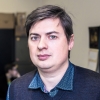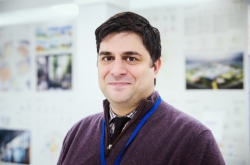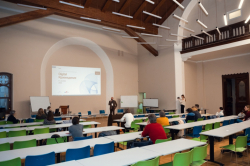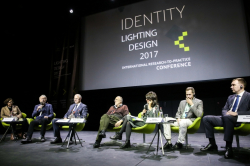What is Digital Humanities?
Since their inception, information technologies started to enter different fields of human activity - engineering, medicine, transport, agriculture and others. Naturally, they started to enter the field of humanities, as well - including humanities research. As of now, humanities specialists make good use of digital technologies in their projects; to grasp the scale of their activity, one can just take a look at the interactive map of Digital Humanities centers - those are spread from the western part of North America all the way to New Zealand.
DH in Russia
The creation of the Russian Digital Humanities community was initiated by the Siberian Federal University - a major structure that unites the leading universities of Krasnoyarsk with help from the European Association for Digital Humanities. On the community's official website, one can see the memorandum and letter from the European association which affirms the legitimacy of the organization. According to its founders, the project's mission is to strengthen the partnership in the field of DH and collaborate on DH projects conducted in Russia and abroad; they also stress that the community itself is always open to new members.
 European Association for Digital Humanities
European Association for Digital Humanities
As we already noted, the community consists of different research teams. One of its key participants is the Moscow History and Computer Association of the Moscow State University. The group publishes the Historical Computer Science magazine that is included in the State Commission for Academic Degrees and Titles' list of recommended magazines. History and Computer Association has many affiliated branches – for instance, the Center for DH Perm University, whose members also take part in different activities in the Digital Humanities field. There are also DH programs for students at the Department of Historical Computer Science of the Moscow State University.
Not long ago, ITMO University also became part of the Digital Humanities community, represented by Artem Smolin, Head of the Department of Engineering and Computer Graphics, and Nikolai Borisov, Head of ITMO's Design and Multimedia Center, who entered the DH Russia's Coordination Board. ITMO University thus also plays its part in the development of the global DH community.
Why we need DH
Even amongst the professional community, the scope of DH is still a topic for discussion. Despite this field of activity having a colossal basis, it has no clear definition, and its interpretation differs from person to person. As of today, DH specialists conduct research with the help of digital communication means and work with electronic data. They develop computer applications for literature studies, linguistics, cultural anthropology and interdisciplinary fields of knowledge, develop digital arts (architecture, music, dramatic art, digital games for education and the related fields), launch, support and promote different resources in the field of humanities. They also introduce DH into the educational process and solve the issues that have to do with the development and introduction of the new digital means for working with text and visual data.
 3D model of an architectural ensemble
3D model of an architectural ensemble
ITMO University focuses on the academic and practical problems of cultural heritage preservation. For instance, we recently wrote about how the university's staff members collaborate with scientists from the Solovki State Historical, Architectural and Natural Museum-Reserve on creating a research and information portal which includes a virtual 3D reconstruction of the Solovetsky Monastery of 16-17th century, as well as an interactive map and virtual tours that make use of 360-degree video and Unity 3D technologies. In other words, ITMO's specialists reconstruct the lost monuments of culture and art using computer technologies, thus creating unique graphical products.
Apart from IT, DH also makes use of different mathematical research. Specialists from the History and Computer association invite mathematicians and develop complex probabilistic mathematical models of different historical processes. For instance, they calculate the probability of particular tribes' migration from one area to another or the effect of harvests in a certain historical period on a certain culture's development. Such work implies the symbiosis of mathematics, programming and historical research.
Where do DH community members meet?
Usually, members of the Digital Humanities community meet at different conferences. Among the leading ones is Siberian Federal University's Digital Humanities Russia conference that is conducted biennially and brings together DH specialists from different countries.
 Digital Humanities Russia conference
Digital Humanities Russia conference
On September 20, 2017, the conference was conducted for the second time. In the course of three days, its participants attended lectures by leading scientists from Switzerland, Germany, Norway, Australia, Ireland, and Russia. The lectors spoke about the first research in the field of Digital Humanities in the middle of 20th century and new projects dedicated to different phenomena: from social media to digitalization of museums and network analysis of literature.
Other major conferences are the International Conference of the History and Computer association and the annual EVA 2017 Saint Petersburg, Electronic Imaging & the Visual Arts conducted by ITMO University.
Projects by DHRussia
Several DH projects were presented at part of the conference in Krasnoyarsk. One was the popular media project "1917. Free History", which is an imitation of social media as they would've looked like in 1917, as well as associated projects from other fields. One can follow the pages of renown poets of that time, repost messages by historical figures and thus feel themselves part of the 1917's events.
Specialists from Siberian Federal University presented an anthology on Digital Humanities sciences, which includes articles by foreign experts recommended for familiarizing oneself with the history of DH. The resource’s target audience is not just students and specialists, but anyone with an interest in modern research methods in humanities.
 Free History project
Free History project
Fekla Tolstaya, a Novosibirsk journalist and great-great-granddaughter of Leo Tolstoy, presented a web-service for transcribing and presenting written texts - Textograph, which is meant to automatize textual critics' work on manuscripts. The system is user-friendly and can work with both prose and poetry, written texts and typescripts. Notably, the service was first tested on Leo Tolstoy's manuscripts: the first 200 pages to be ever used by the program were part of the novel's "War and Peace" manuscript collection.
Lev Manovich, an expert on new media, presented the book "The Language of New Media" that has already become the main manual for this new field.
Specialists from the Department of Historical Computer Science of the Moscow State University presented a project on the virtual reconstruction of the Moscow Strastnoy monastery.
 Anton Smolin at the Siberian Federal University's conference
Anton Smolin at the Siberian Federal University's conference
ITMO University was represented by two of its staff members. Artem Smolin, Head of the Department of Engineering and Computer Graphics, presented a project on the Solovetsky monastery's multimedia information system. Anna Spiridonova, Assistant Professor at the same department shared about her research in the field of using light as media in art and culture.







